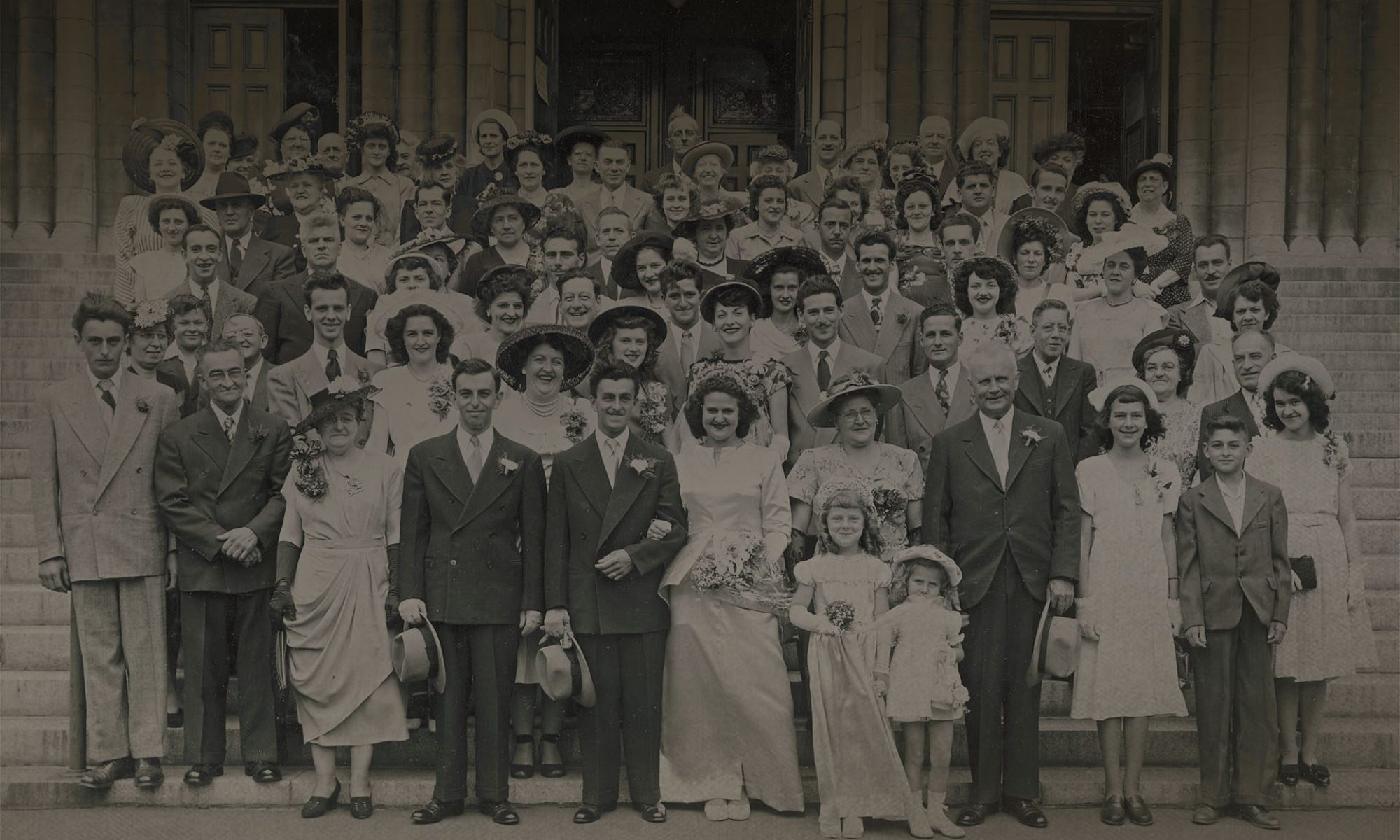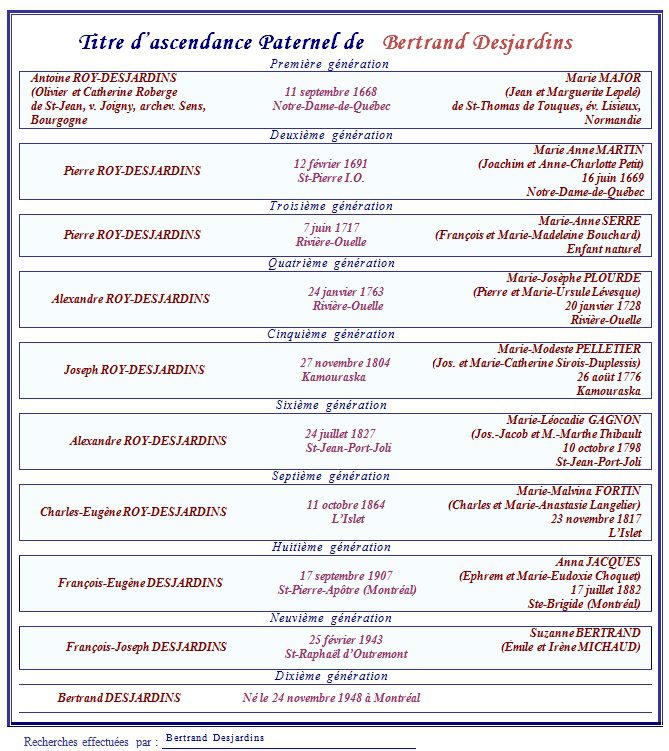This post is also available in: Français

In this guide, you will learn how to trace your ancestry using your subscription to Genealogy Quebec.
Defining ancestry
Your ancestry denotes all of your ancestors as far back as they are traceable, starting with your parents. With each generation, the amount of ancestors you have doubles: 2 parents, 4 grandparents, 8 great grandparents, etc. An ancestry can be total, or can be limited to a subset of ancestors:
- Paternal ancestry (all the ancestors on the paternal side of your ancestry) or maternal ancestry (all the ancestors on the maternal side of your ancestry)
- Patrilineal (father, grandfather, great grandfather, etc.) or matrilineal (mother, grandmother, great grandmother, etc.) An ancestry can be unlimited, going as far back as the genealogical sources allow, or limited to a certain amount of generations.
The key to tracing a line in genealogy is the marriage record, as it contains, in most cases, the names of the parents of the spouses. With these names, you should be able to find the marriage of the parents in question and go back a generation.
Tools
Genealogy Quebec offers multiple tools allowing you to find all kinds of documents and information about your ancestors. However, the LAFRANCE will be your main tool to trace your lineages on the website. It contains the majority of marriages, births and deaths available on Genealogy Quebec and covers a period stretching from the beginnings of the French colony to today.
The process begins with finding a marriage that belongs to a couple of the lineage you are tracing, such as your parents or your grandparents’ marriage, and using the information contained in the record to jump back from generation to generation.
Tracing a line on Genealogy Quebec
Step one – Gathering information
To trace your ancestry using Genealogy Quebec, you must begin by writing down as much as you know about your ancestors, such as names, dates, and locations. It is always a good idea to ask parents, grandparents and other family members for clues and information regarding the family. The more information you start with, the easier your research will be. Make sure to have all this information readily available when starting your research.
Example case, click to expand
Bertrand Desjardins, born on the 24th of November 1948 in Montreal, is attempting to trace his patrilineal ancestry – the Desjardins side – using Genealogy Quebec.
Here is the information gathered by Bertrand before the start of his research.
Subject:
- Bertrand Desjardins, born on the 24th of November 1948 in Montreal
Parents:
- François-Joseph Desjardins born in 1908, died on the 1st of September 1963
- Suzanne Bertrand, born in 1919, died on December 31st 2014,
- The couple married in 1943 in Montreal
Grandparents:
- François-Joseph Desjardins’ father is François Desjardins, who died in July 1955
- François-Joseph Desjardins’ mother is Anna Jacques, who died on September 1st 1975
Additional information:
- François-Joseph Desjardins is the eldest child of his family
- François-Joseph Desjardins’ grandfather is named Charles Desjardins
Step two – Using this information to find a marriage from the lineage
We now have to use the information gathered in the first step to find a marriage from the lineage which will serve as a starting point. To do so, go to the LAFRANCE.
When searching for a record on the LAFRANCE, it is important to stick to the following principles:
- Do not fill in too many fields on your initial search. Your first search should only include the surnames of the spouses. By doing so, you limit the risk of the record being excluded from the results of your search, which can occur when one of the search queries does not exactly match the information contained in the document.
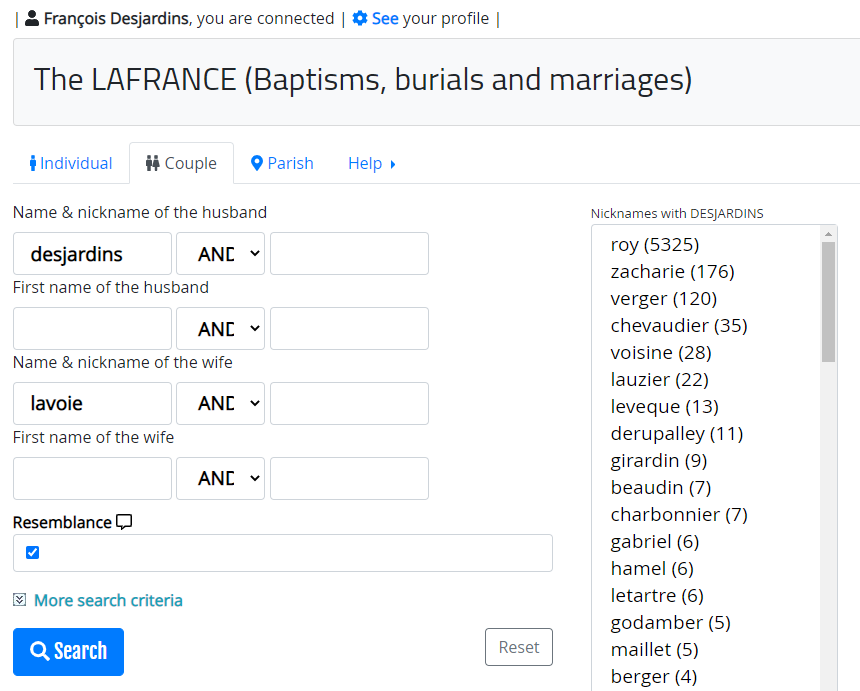
- Try different variations of your search. If your initial search does not allow you to find the document you are looking for, this does not necessarily mean that the document is not available on the LAFRANCE. It is likely that the document is there, but that one of the parameters of your search did not exactly match the information contained in the document, which excluded it from the results.
To overcome this problem, you can try different variations of your search. For example, your initial search might contain the spouses’ surnames only. Your second search would be limited to the husband’s first and last name, without including the wife in the query. Your third search would use the husband’s last name and wife’s first name, and so on. Eventually, if the record is available on the LAFRANCE, one of the variations of your search should allow you to find it.
Finally, it is important to know how to interpret the list of results produced by a search on the LAFRANCE. When you carry out a search by Couple, the results will list every record in which the couple is mentioned, regardless of their role in the record. These can be baptism, marriage or burial records, and the couple can play the role of subjects (the spouses) or parents (parents of the spouses, parents of the newborn child or parents of the deceased person).
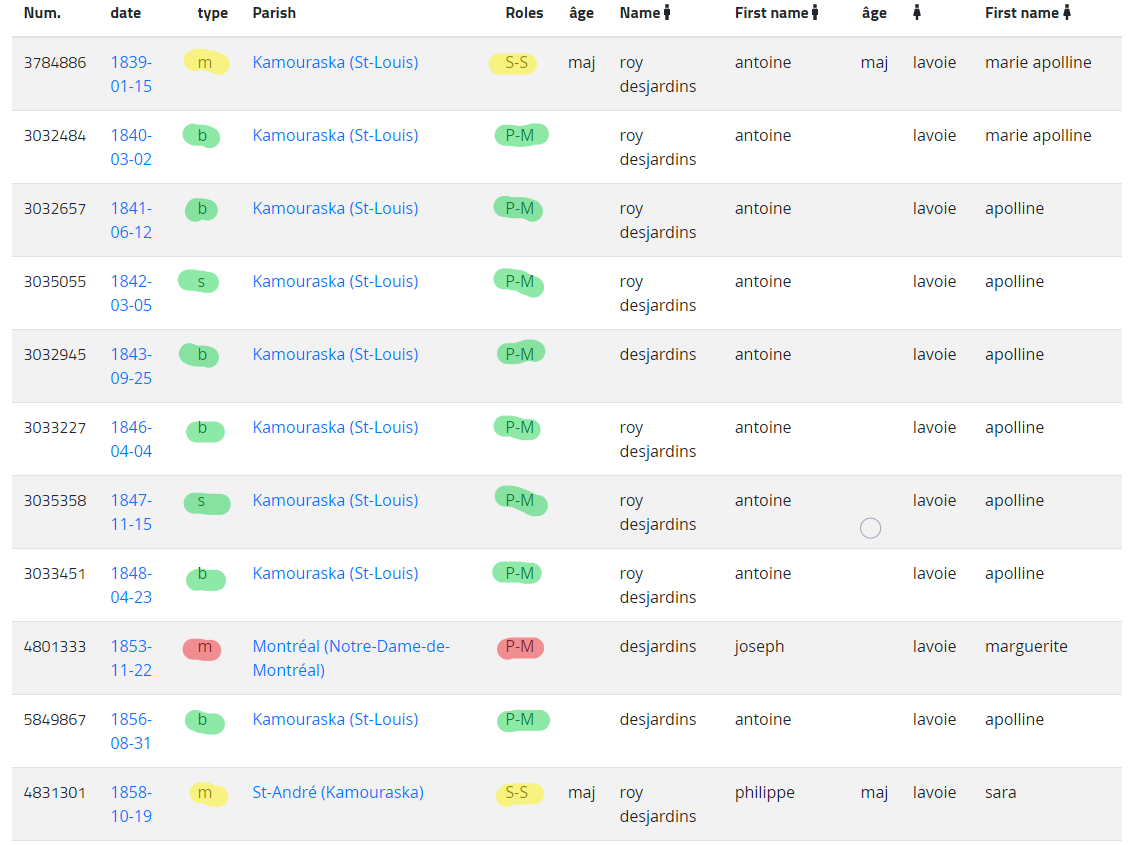
In the list of results obtained from a search on the LAFRANCE, the Type column indicates the type of record in question:
- b: baptism
- m: marriage
- s: burial
The Roles column indicates the role held by the couple in the record:
- S-S: Subject-Subject, the spouses
- P-M: Father-Mother, the parents
- S-C: Subject-Spouse, used when one of the spouses is widowed and the previous spouse is mentioned in the record
As such, in the image above:
- The records highlighted in green are baptisms and burials in which the searched couple are the parents
- The record highlighted in red is a marriage record in which the searched couple are the parents of one of the spouses
- The records highlighted in yellow are marriage records in which the searched couples are the spouses
It is with marriages (m) in which the searched couple are the subjects (S-S) that we will be tracing lineages.
Example case, click to expand
Equipped with the information gathered during the first step, Bertrand is now ready to find the marriage that will serve as the starting point for his research.
Bertrand initially decides to begin his research with the marriage of his parents François-Joseph Desjardins and Suzanne Bertrand. Unfortunately, despite multiple attempts, the marriage does not seem available on the LAFRANCE.
Therefore, Bertrand turns to the marriage of his grandparents, François Eugène Desjardins and Anna Jacques.
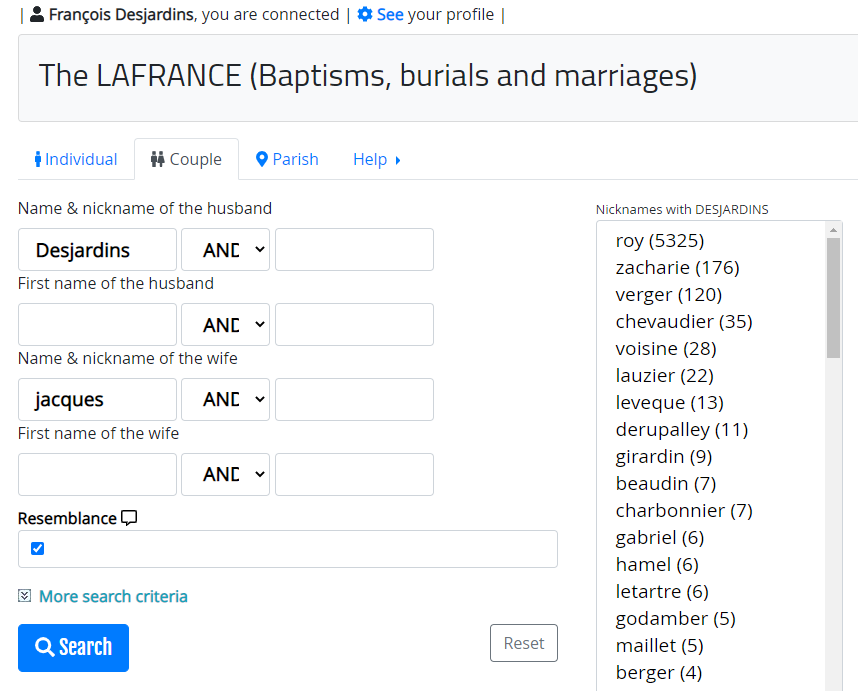
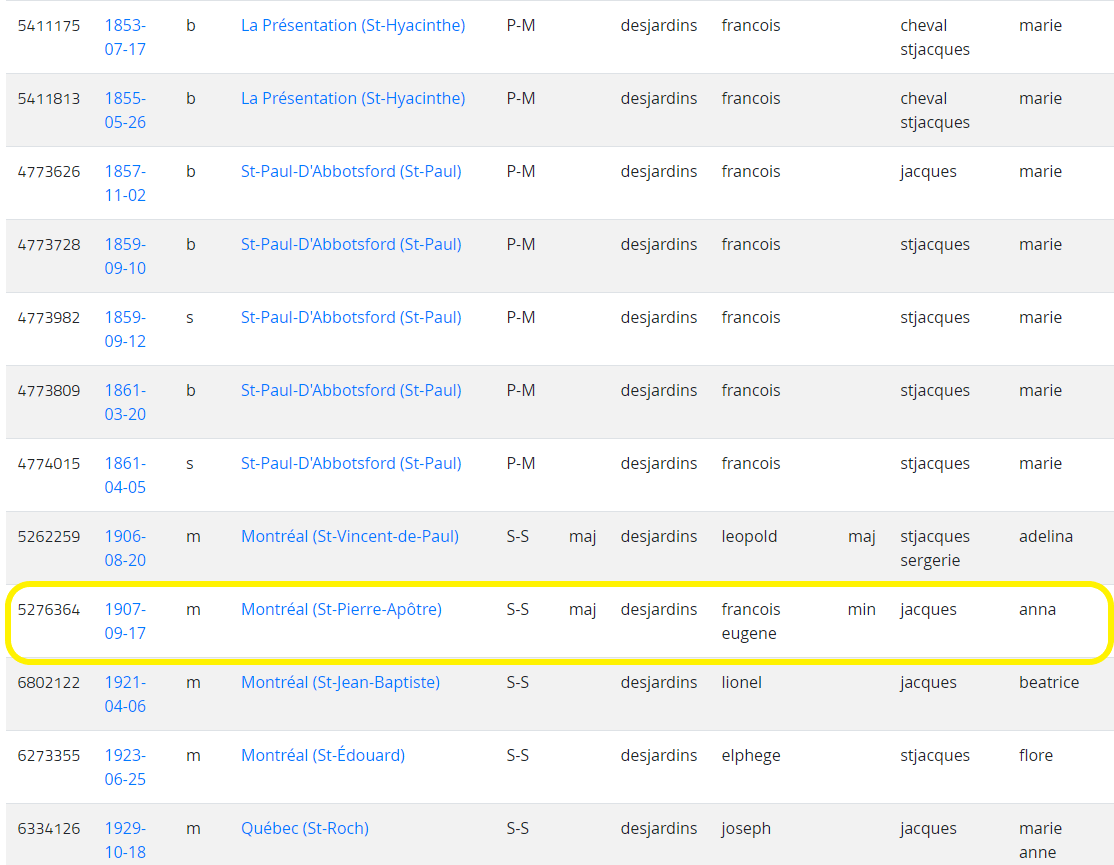
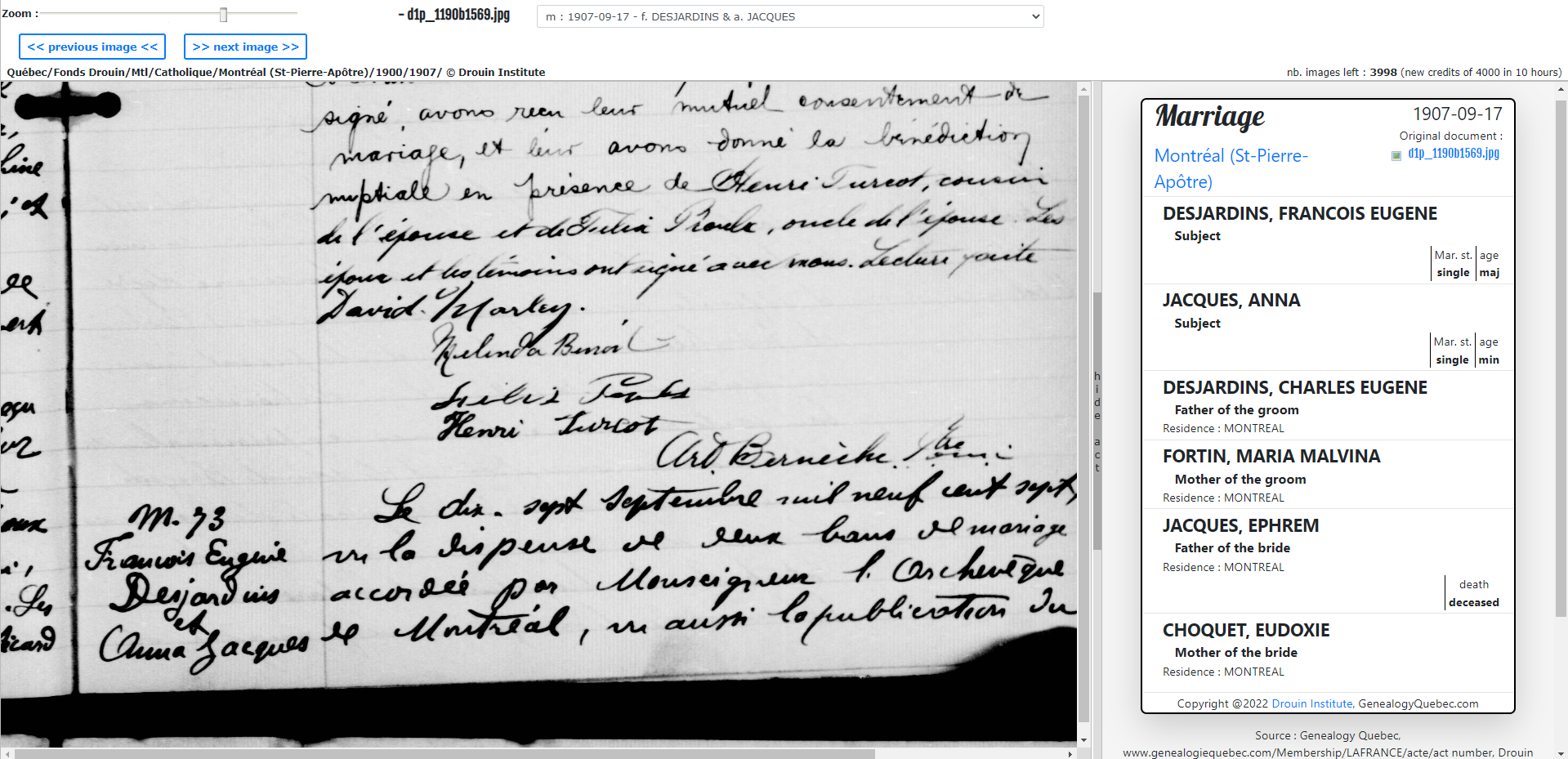
His search successful, Bertrand now has the information required to go back a generation in his paternal line. To do so, he will have to find the marriage of the parents of François Eugène Desjardins: Charles Eugène Desjardins and Marie Malvina Fortin.
Third step – Going back one generation at a time
With a marriage from your lineage in hand, you are now in a position to find your ancestors. To do so, you will have to find the husband’s (or wife’s) parents marriage, which will allow you to go back a generation.
A simple LAFRANCE search using their names should allow you to do so.
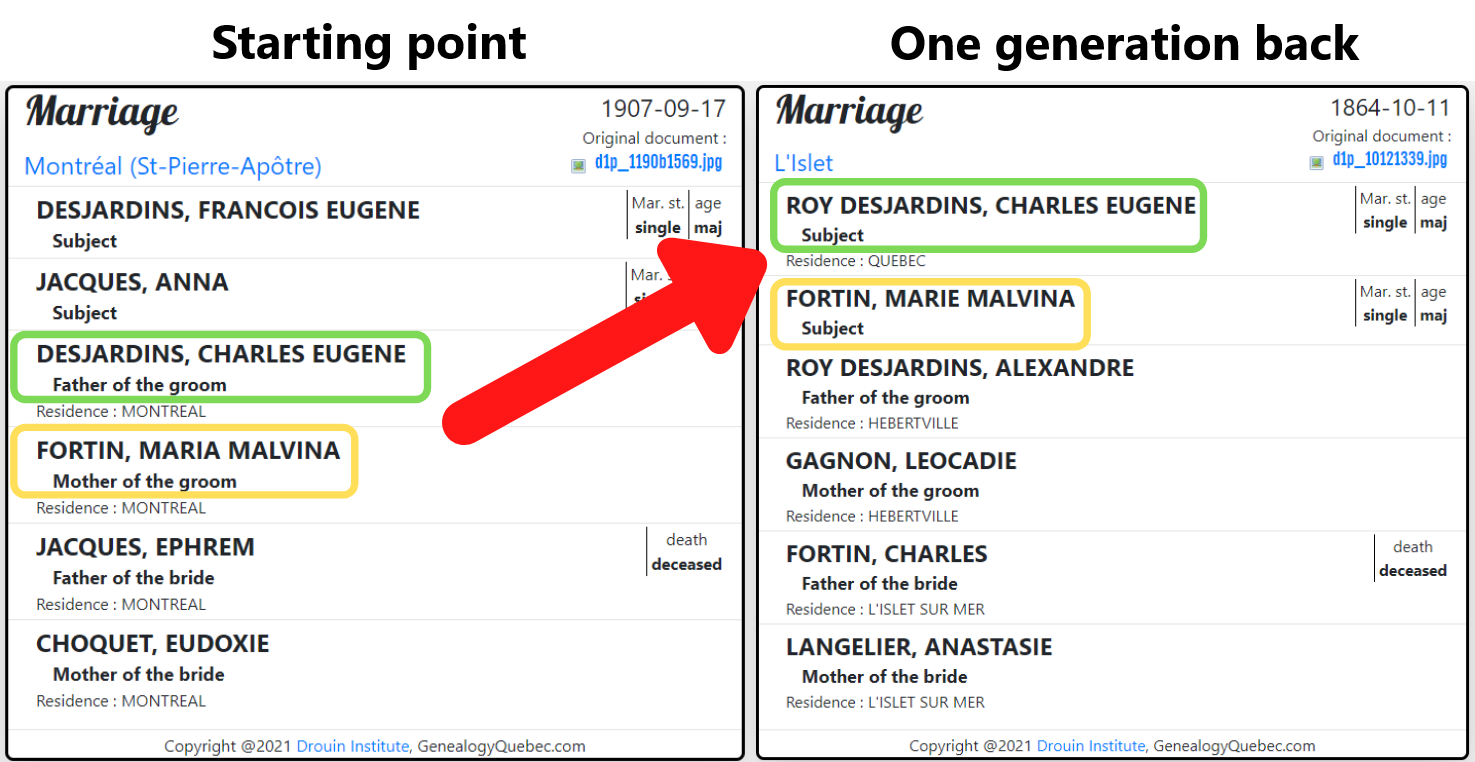
This process is repeated until you reach the first generation of your line to have set foot in Quebec, often in the 18th or even the 17th century. Depending on your family, you may have more than a dozen generations to trace back before you get to the first immigrant.
Example case, click to expand
Thanks to the marriage of his grandparents found earlier, Bertrand knows that his paternal great-grandparents are Charles Eugène Desjardins and Marie Malvina Fortin. He must now find their marriage using the LAFRANCE.
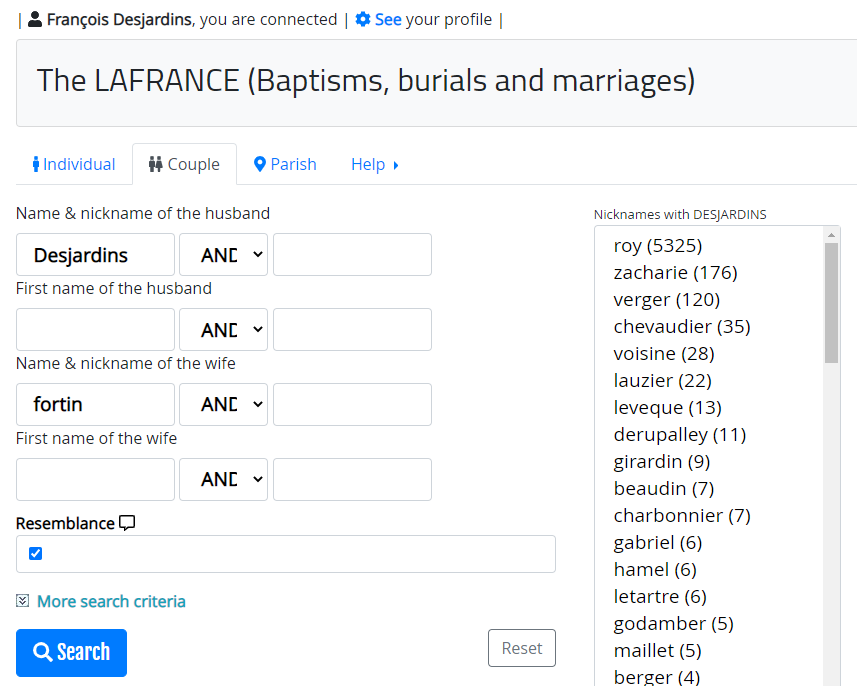
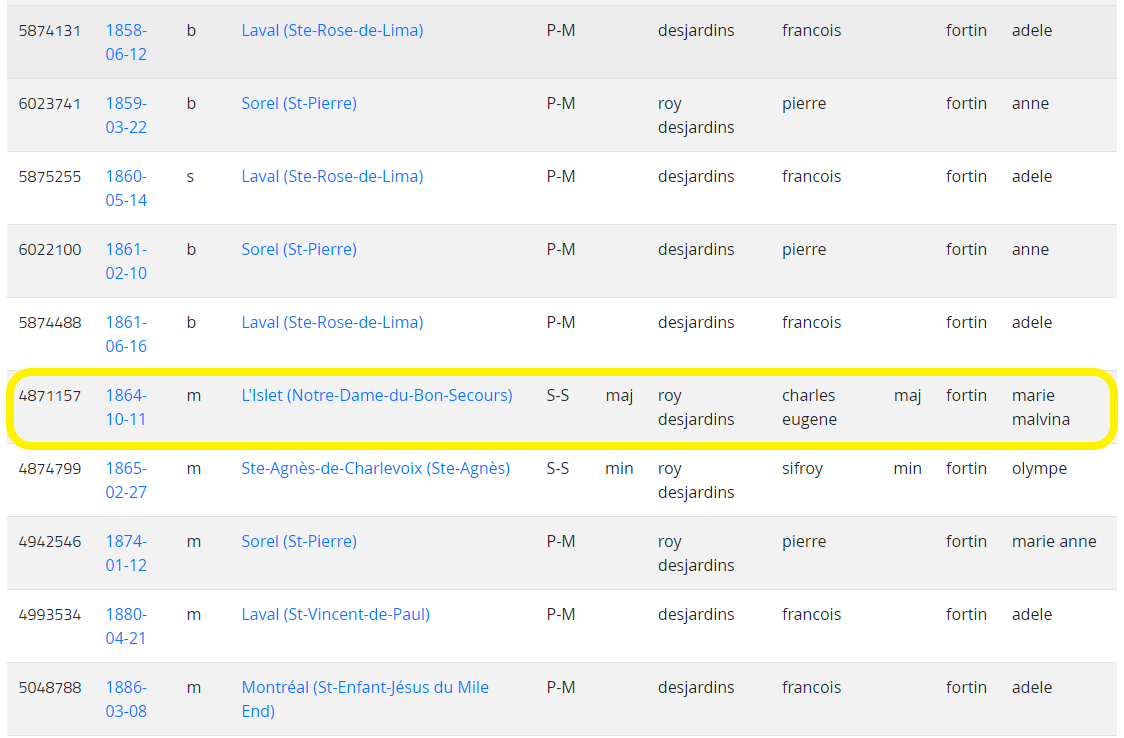
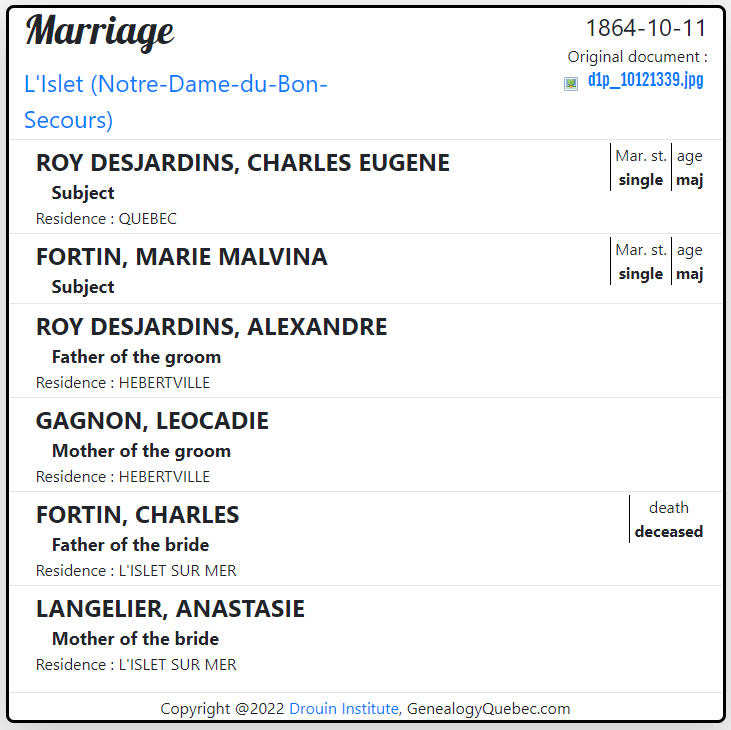
Charles Eugène Desjardins’ marriage indicates that his parents are Alexandre Roy Desjardins and Léocadie Gagnon. Bertrand must now find their marriage and repeat the process again and again, until he reaches the first immigrant of his paternal line.
Six generations later, Bertrand finds the marriage of the first immigrant of his line, Alexandre Roy dit Desjardins, who married Marie Major on September 11, 1668 in Quebec.
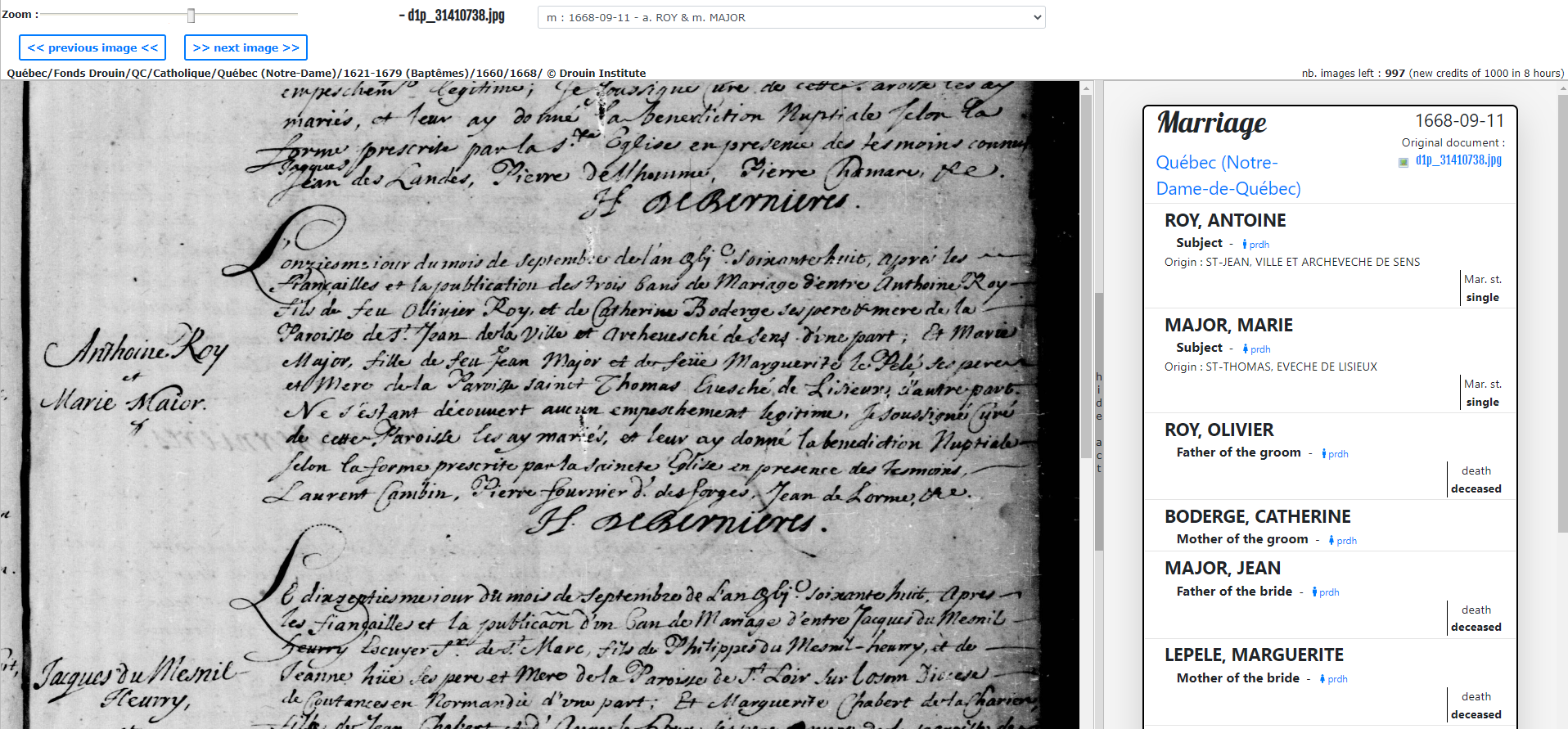
Thanks to the LAFRANCE, Bertrand was able to trace his paternal line as far back as the 17th century in minutes.
If you cannot find a marriage in the LAFRANCE
The LAFRANCE contains all Catholic marriages recorded in Quebec prior to 1919, but coverage from 1919 to the present day is not exhaustive. Because of this, you may not be able to find a marriage of your lineage if the information gathered in the first step of your research does not allow you to go back to 1919 or prior.
If this is the case, we suggest that you carry out a search in the LAFRANCE for a death record relating to an individual of the lineage you are researching, since these can also be used as a starting point for your research.
Indeed, death records usually mention the names of the parents of the deceased person. As a result, you could search for the death record of your most distant known paternal ancestor, and obtain the names of his parents from the record, thus allowing you to go back one generation. The next step is to find the marriage of the parents in question, and follow the procedure explained in step two.
Example case, click to expand
Thanks to the information gathered by Bertrand at the start of his research, it was easy for him to find the marriage of his grandparents in the LAFRANCE.
Now imagine a scenario in which Bertrand was unable to gather basic information such as the names of his grandparents. Essentially, Bertrand’s starting point is the names of his parents, their date of marriage, their year of birth and the date of death of his father.
- François-Joseph Desjardins, born in 1908, died on September 1st 1963
- Suzanne Bertrand, born in 1919, died on December 31st 2014
- Married in 1943 in Montreal
The marriage of Bertrand’s parents can be found in the LAFRANCE, but it does not contain the names of his grandparents; it’s a dead end.
Therefore, Bertrand turns to death records. A LAFRANCE search for a Desjardins who died in 1963 allows Bertrand to find his father’s death record.
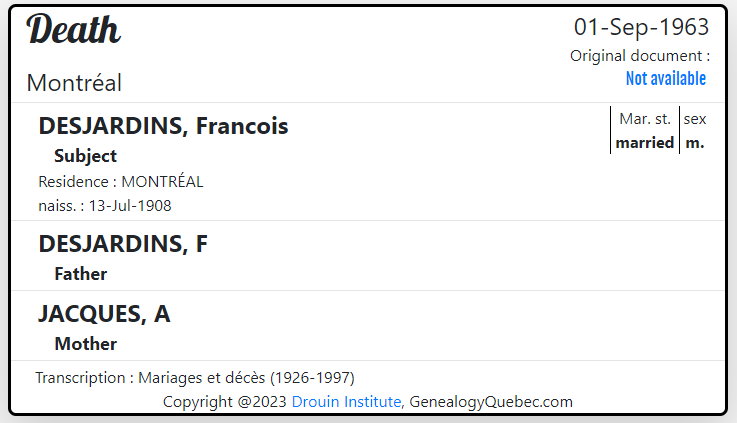
The record indicates that the names of François-Joseph Desjardins’s parents are F. Desjardins and A. Jacques. A search for a Desjardins/Jacques couple in the LAFRANCE leads to their marriage, which will serve as Bertrand’s starting point in his attempt to trace his paternal line.
Do not hesitate to contact us at contact @ institutdrouin.com if you have any questions regarding this guide or the process of retracing your ancestors.
